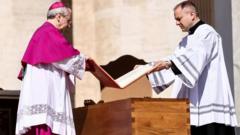
The Final Journey: Tradition and Transition in a Papal Funeral
The passing of a Pope marks a significant moment not only for the Catholic Church but for the world. The carefully orchestrated ceremonies that follow are steeped in centuries of tradition, blending solemn mourning with the affirmation of continuity and the beginning of a new chapter. This article explores the key elements expected in the final journey of Pope Francis, drawing upon historical precedents and informed speculation regarding any potential adaptations or innovations.
The Interregnum: A Period of Transition
Upon the Pope's death, the period known as the Sede Vacante, or "vacant see," begins. This period is characterized by specific protocols and responsibilities assumed by designated officials. The Camerlengo, currently Cardinal Kevin Farrell, plays a crucial role. He officially confirms the Pope’s death, typically by gently striking the late Pope's forehead with a silver hammer and calling his baptismal name. This symbolic act, while historically accurate, may be adapted for modern sensibilities. He also seals the papal apartments and manages the administrative affairs of the Vatican during the interregnum.
The College of Cardinals assumes governance of the Church during this interim period. They are responsible for organizing the funeral rites and, most importantly, the conclave to elect the next Pope. The details of the Pope's will, if one exists, will also be reviewed and executed according to canon law.
The Lying in State: Paying Final Respects
Following the confirmation of death, the body of the Pope is prepared for public viewing. This involves embalming and dressing the body in papal vestments. The Pope will then lie in state, traditionally in St. Peter's Basilica, allowing the faithful from around the world to pay their respects. Large crowds are anticipated, necessitating careful security measures and logistical planning to manage the flow of mourners.
The lying in state typically lasts for several days, providing ample opportunity for pilgrims and dignitaries to offer their condolences. The length of this period may be adjusted depending on the circumstances and the desire to accommodate as many people as possible.
The Funeral Mass: A Celebration of Life and Faith
The funeral Mass, or Missa pro defuncto Pontifice, is a solemn and elaborate liturgical celebration held in St. Peter's Square. It is presided over by the Dean of the College of Cardinals, currently Cardinal Giovanni Battista Re, although other cardinals will concelebrate. Dignitaries from around the world, including heads of state, religious leaders, and representatives of international organizations, are expected to attend.
The Mass includes specific prayers, readings, and hymns appropriate for the occasion. The homily is typically delivered by a prominent cardinal and focuses on the life, ministry, and legacy of the deceased Pope. The ceremony is usually broadcast live to a global audience, allowing millions to participate remotely.
The Burial: A Return to Sacred Ground
Following the funeral Mass, the Pope's body is entombed in the Vatican Grottoes, located beneath St. Peter's Basilica. These grottoes house the tombs of many of the previous Popes. The specific location of the tomb is determined by the College of Cardinals, often in accordance with the wishes of the deceased Pope. The burial is a private ceremony attended by a limited number of cardinals and Vatican officials.
The Pope's remains are typically placed in three coffins: one made of cypress, one of lead, and one of elm. The cypress coffin contains the Pope's body, while the lead coffin is inscribed with details of his pontificate. The elm coffin provides a final layer of protection.
Symbolic Changes and Potential Innovations
While the core elements of the papal funeral are rooted in tradition, each ceremony reflects the unique personality and priorities of the deceased Pope and the evolving practices of the Church. Pope Francis, known for his emphasis on simplicity and pastoral care, may have expressed wishes for a less ostentatious ceremony. It is possible that certain aspects of the funeral rites will be streamlined or adapted to reflect his values.
- Simplicity in Vestments: The Pope's known preference for simpler vestments might extend to the funeral attire.
- Focus on the Poor: The sermon may emphasize his dedication to serving the marginalized.
- Ecumenical Outreach: Invitations to leaders of other faiths could be extended as a gesture of unity.
Furthermore, advancements in technology and media coverage may influence the way the funeral is presented to the world. Live streaming, virtual reality experiences, and interactive online platforms could be utilized to allow a broader audience to participate in the mourning process and learn about the life and legacy of Pope Francis.
The Conclave: Electing a Successor
While not strictly part of the funeral rites, the conclave to elect the next Pope is an integral part of the transition process. Held in the Sistine Chapel, the conclave is a secret meeting of the College of Cardinals, who deliberate and vote until a two-thirds majority is achieved. The election of a new Pope signals the end of the Sede Vacante and the beginning of a new era for the Catholic Church.
The world will be watching as the Church navigates this period of mourning and transition, adhering to ancient traditions while embracing the challenges and opportunities of the modern era. The final journey of Pope Francis will be a moment of reflection, remembrance, and renewal for Catholics worldwide.
```